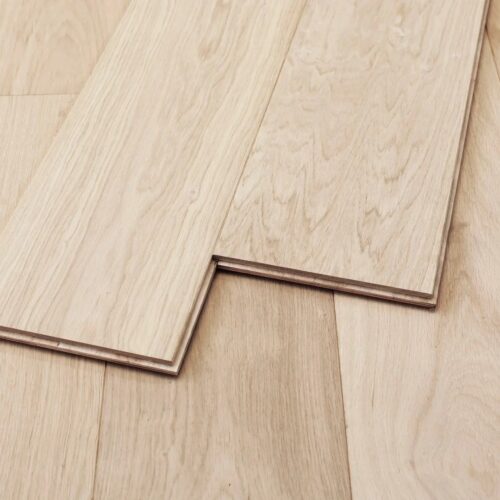introduction
Can Engineered Wood Flooring be Sanded?
When it comes to maintaining the beauty and longevity of engineered wood floors, property owners often wonder if sanding is a viable option with engineered wood flooring. The good news is that engineered wood floors can indeed be sanded. However, not all engineered woods are created equal – the key factor that permits how many times the floor can be sanded, if at all, is the thickness of the wear layer but wear layer alone is not the only factor to consider. Read on to find out more….

Wear Layers?
Understanding Wear Layers in Engineered Flooring
Our range of Engineered wood floors are constructed from multiple layers of plywood, topped with a hardwood veneer, known as the wear layer. This uppermost layer is what gives the floor its aesthetic finish and what can potentially be sanded. The thickness of this wear layer varies significantly among different engineered products.
Typically, you’ll find wear layers ranging from 1mm to 6mm thick. Floors on the lower end of this spectrum are unlikely to withstand sanding, as the process can wear through the thin veneer altogether. Conversely, engineered floors with thicker wear layers offer more hardwood to work with, making them suitable for sanding and refinishing.
Life Expectancy
Wear Layer Thickness vs Finish Quality
While the thickness of the wear layer does play a significant role in determining the life expectancy of a wood floor, it’s not the only factor to consider. The quality of the finish applied to the engineered flooring is equally important. A high-quality finish will protect the floor from scratches, dents, and stains, reducing the frequency at which sanding is needed.
Good maintenance also extends the life of your engineered wood floor. Cleaning with the appropriate cleaning solution and avoiding harsh chemicals can significantly increase the time between sands. More on this below.
How Often Should You Sand Your Engineered Floor?
The necessity and frequency of sanding an engineered wood floor depend largely on the wear-and-tear the flooring undergoes and, as mentioned above, how durable the finish is. In most residential settings, a flooring with a high quality finish can last well over a decade before sanding is necessary. However, in a high-traffic commercial environment, the floor could require sanding more frequently.
A real life example – At the time of writing this article, my kitchen floor is 6 years old and I have 2 cats (regular muddy paws), a dog (lively, drippy, muddy) and a very lovely partner (great cook, but ingredients gets everywhere). I have not had to re-finish or sand my floor and this is thanks to the high quality Treatex Hardwax Oil finish that I applied when the floor was first installed.
Before you undertake sanding, it could be important to consult with a professional. An expert can assess the wear layer thickness and the floor’s overall condition to determine whether sanding is advisable. If the wear layer is too thin, sanding could damage the floor beyond repair.
the challenges
Patch Repair and Sectional Sanding
Pre-Treated vs. On-Site Finished Floors
When it comes to maintaining engineered wood floors, addressing isolated damage or wear can be a complex task. Patch repair and sectional sanding are techniques used to refurbish specific areas of the flooring without having to sand the entire surface. However, this localised approach presents unique challenges, especially when dealing with pre-treated flooring (factory applied finishes).
Engineered floors that come with a factory-applied finish right out of the box offering short term convenience but these finishes can make patch repairs more difficult. Matching the colour and sheen of the original factory finish requires precision and expertise, as manufacturers often use proprietary blends and application methods that are not easily replicated on-site.
On the other hand, floors that are treated on site provide a different advantage. Since the finish is applied after installation, homeowners have complete control over the type of finish and the application process. This makes it easier to watch the finish if conducting patch repairs or sectional sanding later on. If damage occurs, the same products and techniques used initially can be employed to blend the repaired section seamlessly with the rest of the floor.
Techniques for Successful Patch Repairs
To successfully sand and refinish a small section of an engineered wood floor, consider the following steps:
- Identify the Finish: Determine the type of finish used on your flooring. If it’s a factory finish, gather information from the manufacturer regarding the specific products and methods used.
- Colour Matching: For floors which have had a stain applied, finding the exact stain match is important. Test the stain on a spare piece of the same flooring or in an inconspicuous area before applying it to the damaged section.
- Gradual Blending: When sanding and refinishing the affected area, feather the edges to help blend the repair into the surrounding floor. This helps to prevent noticeable lines or transitions. Alternatively, sand boards in their entirety to disguise any subtle differences in colour of boards as natural colour variation.
- Finish Application: Apply the finish carefully, replicating the original application method if possible. Multiple thin coats may be necessary to match the sheen and build of the existing finish.
- Professional Insight: If you’re unsure about any step in the process, consulting with a flooring professional can save time and prevent further damage to your floor.
can you sand engineered wood flooring?
Conclusion
In summary, yes, you can sand an engineered wood floor, but with caveats. The thickness of the wear layer and the quality of the finish both influence the feasibility and frequency of sanding. To ensure the long-term viability of your flooring, proper care and occasional assessment are recommended and by understanding these important aspects, you can maintain and enjoy the timeless beauty of your engineered wood floors for a lifetime.


